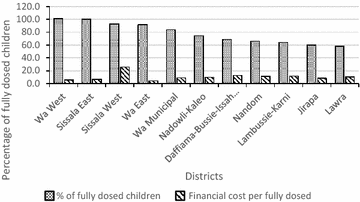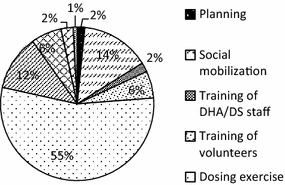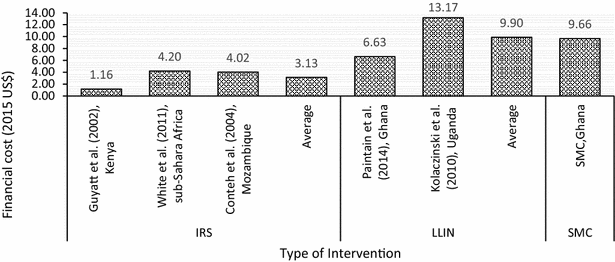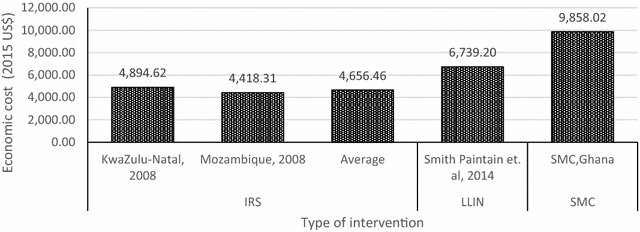Cost-effectiveness of seasonal malaria chemoprevention in upper west region of Ghana
- PMID: 27423900
- PMCID: PMC4947302
- DOI: 10.1186/s12936-016-1418-z
Cost-effectiveness of seasonal malaria chemoprevention in upper west region of Ghana
Abstract
Background: In Ghana, malaria is endemic and perennial (with significant seasonal variations in the three Northern Regions), accounting for 33 % of all deaths among children under 5 years old, with prevalence rates in children under-five ranging from 11 % in Greater Accra to 40 % in Northern Region. Ghana adopted the WHO-recommended Seasonal Malaria Chemoprevention (SMC) strategy with a trial in the Upper West Region in 2015. The objective of this study was to estimate the cost-effectiveness of seasonal malaria chemoprevention.
Methods: Costs were analysed from provider and societal perspectives and are reported in 2015 US$. Data on resource use (direct and indirect costs) of the SMC intervention were collected from intervention records and a survey in all districts and at regional level. Additional numbers of malaria cases and deaths averted by the intervention were estimated based on prevalence data obtained from an SMC effectiveness study in the region. Incremental cost-effectiveness ratios (ICERs) were estimated for the districts and region. Sensitivity analyses were conducted to test the robustness of the ICERs.
Results: The total financial cost of the intervention was US$1,142,040.80. The total economic cost was estimated to be US$7.96 million and US$2.66 million from the societal and provider perspectives, respectively. The additional numbers of cases estimated to be averted by the intervention were 24,881 and 808, respectively. The economic cost per child dosed was US$67.35 from societal perspective and US$22.53 from the provider perspective. The economic cost per additional case averted was US$107.06 from the provider perspective and US$319.96 from the societal perspective. The economic cost per additional child death averted by the intervention was US$3298.36 from the provider perspective and US$9858.02 from the societal perspective. The financial cost per the SMC intervention delivered to a child under-five was US$9.66. The ICERs were sensitive to mortality rate used.
Conclusions: The SMC intervention is economically beneficial in reducing morbidity in children under-5 years and presents a viable approach to improving under-five health in Ghana.
Keywords: Ghana; Incremental cost-effectiveness ratios; Seasonal malaria chemoprevention; Under-five.
Figures







Similar articles
-
Cost-effectiveness of district-wide seasonal malaria chemoprevention when implemented through routine malaria control programme in Kita, Mali using fixed point distribution.Malar J. 2021 Mar 4;20(1):128. doi: 10.1186/s12936-021-03653-x. Malar J. 2021. PMID: 33663488 Free PMC article.
-
Seasonal malaria chemoprevention in northern Mozambique: a cost-effectiveness analysis.Malar J. 2025 May 21;24(1):159. doi: 10.1186/s12936-025-05401-x. Malar J. 2025. PMID: 40399941 Free PMC article.
-
Seasonal malaria chemoprevention in the Sahel subregion of Africa: a cost-effectiveness and cost-savings analysis.Lancet Glob Health. 2021 Feb;9(2):e199-e208. doi: 10.1016/S2214-109X(20)30475-7. Lancet Glob Health. 2021. PMID: 33482140
-
Malaria treatment and prophylaxis in endemic and nonendemic countries: evidence on strategies and their cost-effectiveness.Future Microbiol. 2011 Dec;6(12):1485-500. doi: 10.2217/fmb.11.138. Future Microbiol. 2011. PMID: 22122444 Review.
-
Seasonal malaria chemoprevention in Africa and China's upgraded role as a contributor: a scoping review.Infect Dis Poverty. 2023 Jul 5;12(1):63. doi: 10.1186/s40249-023-01115-x. Infect Dis Poverty. 2023. PMID: 37403183 Free PMC article.
Cited by
-
Cost-effectiveness of district-wide seasonal malaria chemoprevention when implemented through routine malaria control programme in Kita, Mali using fixed point distribution.Malar J. 2021 Mar 4;20(1):128. doi: 10.1186/s12936-021-03653-x. Malar J. 2021. PMID: 33663488 Free PMC article.
-
Therapeutic efficacy of artesunate-amodiaquine and artemether-lumefantrine combinations for uncomplicated malaria in 10 sentinel sites across Ghana: 2015-2017.Malar J. 2019 Jun 24;18(1):206. doi: 10.1186/s12936-019-2848-1. Malar J. 2019. PMID: 31234874 Free PMC article.
-
Cost-Effectiveness of Focal Mass Drug Administration and Mass Drug Administration with Dihydroartemisinin-Piperaquine for Malaria Prevention in Southern Province, Zambia: Results of a Community-Randomized Controlled Trial.Am J Trop Med Hyg. 2020 Aug;103(2_Suppl):46-53. doi: 10.4269/ajtmh.19-0661. Am J Trop Med Hyg. 2020. PMID: 32618249 Free PMC article. Clinical Trial.
-
Reducing Malaria Mortality at the Lowest Budget: An Optimization Tool for Selecting Malaria Preventative Interventions Applied to Ghana.MDM Policy Pract. 2019 Jul 25;4(2):2381468319861346. doi: 10.1177/2381468319861346. eCollection 2019 Jul-Dec. MDM Policy Pract. 2019. PMID: 31384668 Free PMC article.
-
Evaluating malaria burden in children under-five and intervention outcomes in Tarkwa-Nsuaem municipality.BMC Infect Dis. 2025 Feb 28;25(1):294. doi: 10.1186/s12879-025-10705-z. BMC Infect Dis. 2025. PMID: 40021974 Free PMC article.
References
-
- WHO . World Malaria Report 2015. Geneva: World Health Organization; 2015.
-
- Ghana Health Service . National malaria control programme annual report 2014. Ghana Health Service: Republic of Ghana; 2014.
-
- Ghana Statistical Service. Ghana Health Service (GHS) ICF International . Ghana demographic and health survey 2014. Rockville: GSS, GHS, and ICF International; 2015.
-
- World Health Organization . World Malaria Report 2013. Geneva: World Health Organization; 2014.
Publication types
MeSH terms
Substances
LinkOut - more resources
Full Text Sources
Other Literature Sources
Medical

